How well do you know about harmonica? Have you ever wondered what musical scales you can play on this instrument? Ponder on the techniques the current lesson offers to you if you really want to enhance your knowledge about scales, even if it's a single scale you want to master. After thorough reading of this write-up, it would be much easier for you to perform the scales on a harp.

If your perception relating this topic is limited, I can promptly explain what actually is a musical scale? It's a series of notes following a certain pattern where notes are organized in a repeated sequence of intervals. For example, the major scale presents a string of intervals, e.g. tone, tone, semitone, tone, tone, tone, semitone. In fact, the C major scale is created by the notes C, D, E, F, G, A and B.
There are several sorts of scales categorized according to distinct criteria, e.g. those regarded as main are the major ones, some other as the diminished ones, the minor ones (there are different types of sclaes), then we have the seventh and so on.
We can also play scales consisting of 5 or 6 notes such as the blues scale and the pentatonic scale. Each of these scales has a precise scheme and it denotes peculiar characteristic features to the music. In this lesson we are going to analyze some of thiese note sequences.
We can play different musical scales on harmonica, some are completed on a single octave, others complete on one or more octaves, whereas some are partially reproducible. Undoubtedly, we can play more musical scales if we apply the bending technique accurately. Likewise, if we are capable of performing the overbending technique successfully on the harp, we can play all of the musical scales. Those who know how to play the diatonic harmonica in a chromatic way can perform, in fact, the scales on all the 12 semitones that constitute our tonal system.
In this article, we'll analyze some of the dominant musical scales which can be played on a diatonic C harp. Everything we learn in this regard will be applicable to any other harmonica and for every key.
Let's begin with the scale that takes its name after the key of the chosen harmonica, then the C major scale which is formed by the notes C, D, E, F, G, A and B.
Let's also evaluate the possibility of playing this scale on the C harp, considering its three octaves that it yields:
On holes 1 to 4 - by using bending on holes 2 and 3 - we may perform the whole scale, cause we can play the notes F and A on the low side of the harp.
On holes 4 to 7, we can play the whole scale in a simple way; i.e. even without using the bent notes.
On holes 7 to 10; although we can still play the whole scale, but we must use a half-tone bend to play the B on hole 10.
As you can see in the diagram below, the harmonica played in the first position allows us to perform the reference scale in a much relaxed way.
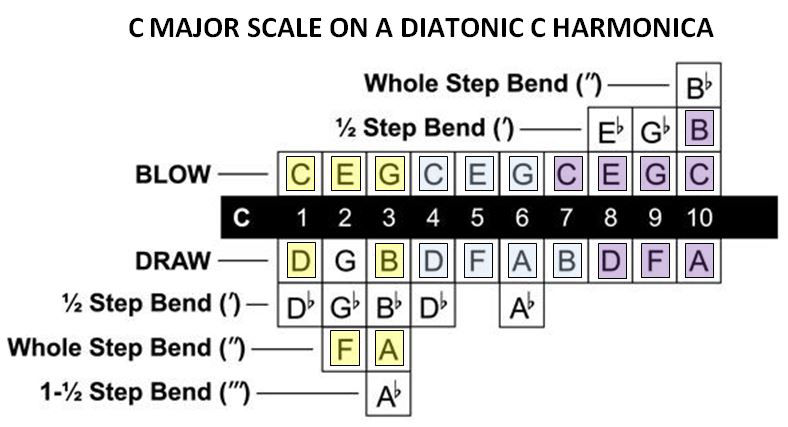
Now let's see another major scale which we can play on harmonica, i.e. the D major. This scale is formed by the notes D, E, F#, G, A, B, C#.
On holes l to 4, the whole scale can be played by bending holes 2 and 4 to produce F sharp and C sharp. On the holes 4 to 8, though, we are only allowed to play the scale partially since we don't have the note F sharp. Practically speaking, this aspect is crucial enough to infer that we can only take advantage from the first octave of the instrument on holes l to 4, if we want to play major D tune, in third position on a C harmonica.
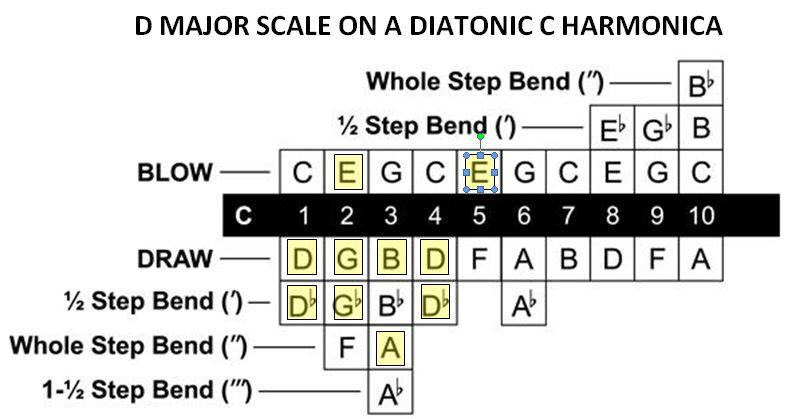
Instead, Let's see how we can play the D minor scale, dorian mode, produced by the notes D, E, F, G, A, B and C , on a minor song, while staying in third position?
What we find out is the conclusion that all such sound notes can be easily played on the three octaves of the harmonica extension. Nonetheless, we need to use the bending if we wish to play F on hole 2 or B on hole 10.
We may deduce that the diatonic harmonica can be recommended for playing in third position on a minor track. Just be aware that in this context is better to avoid playing the B natural note that doesn’t sound well.
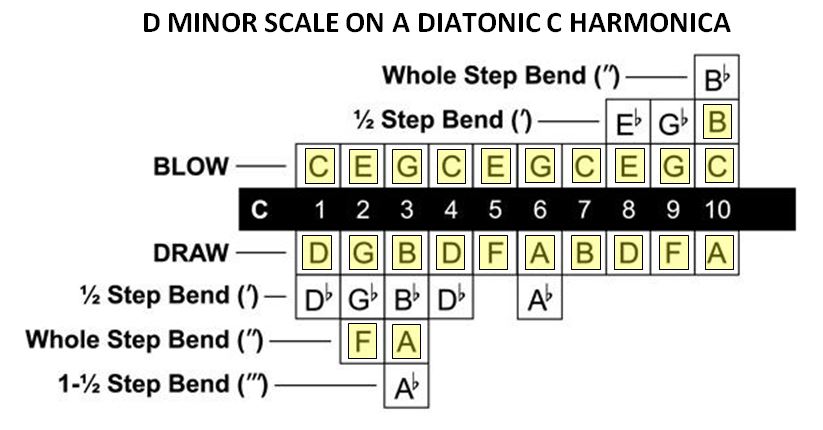
Let's now analyze E major scale which is formed by notes E, F#, G#, A, B, C#, D#.
This scale can be played on the first octave of the harmonica, on holes 2 to 5, but the D sharp is missing here. We can play the same scale including natural D instead, in that case we are playing to play the E7 scale.
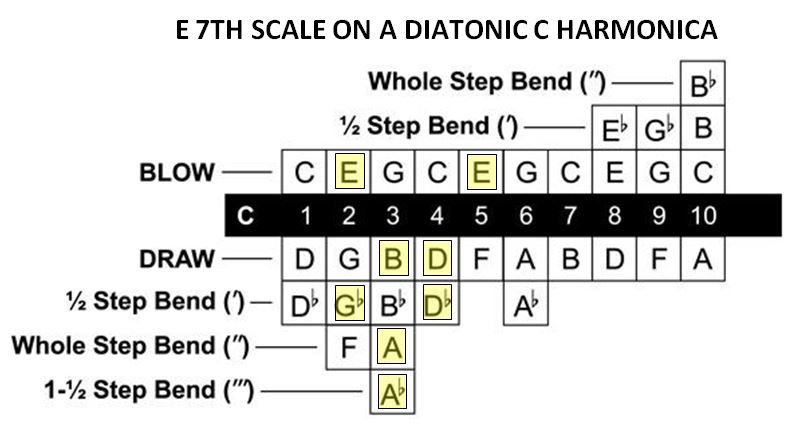
If we conduct the same analysis for E minor scale, we can perform these notes as follows:
On the holes 2 to 5, a full scale can be initiated with the notes E, F#, G, A, B, C, D, E.
What characterizes the minor scale are minor third (G) and minor seventh (D) both. If we want to play smoothly on all the harmonica extension, we can use the E minor pentatonic scale, generated by the notes E, G, A, B and D. Being efficacious, this scale is widely used for playing in fifth position on minor tracks.
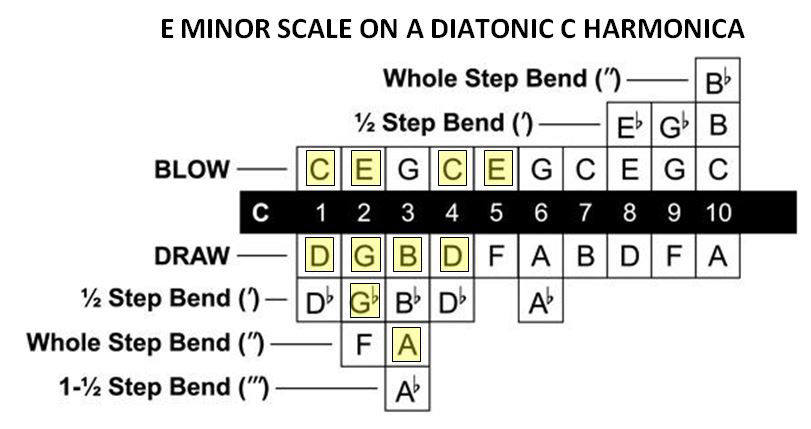
You must be wondering about the blues scales at this point? Now, you should take the challenge of analyzing harmonica on your own and find out how to play the following scales:
G blues scale, formed by the notes G, Bb, C, C#, D, F.
D blues scale, formed by the notes D, F, G, G#, A, C.
E blues scale, formed by the notes E, G, A, A# B, D.
I am sure, you'll be able to play all of them on the first five holes of the harmonica, wouldn't you?
If you want to comment this lesson use the contact form available here.
Mike Awish
Scales cover a really important role in music learning. Understand where you can play them on harmonica is crucial if you want to play better. Thanks for this clear lesson.
Bruce Lo Rino
I wasn't aware we can play so many scales on harp. Thank you for this lesson, I'm going to practise harmonica scales regularly starting from today!
Lewis Johnson
Great lesson, I think once I'll master the scales I will be able to improvise more and better. I will have a look at your online school courses too. Thanks.